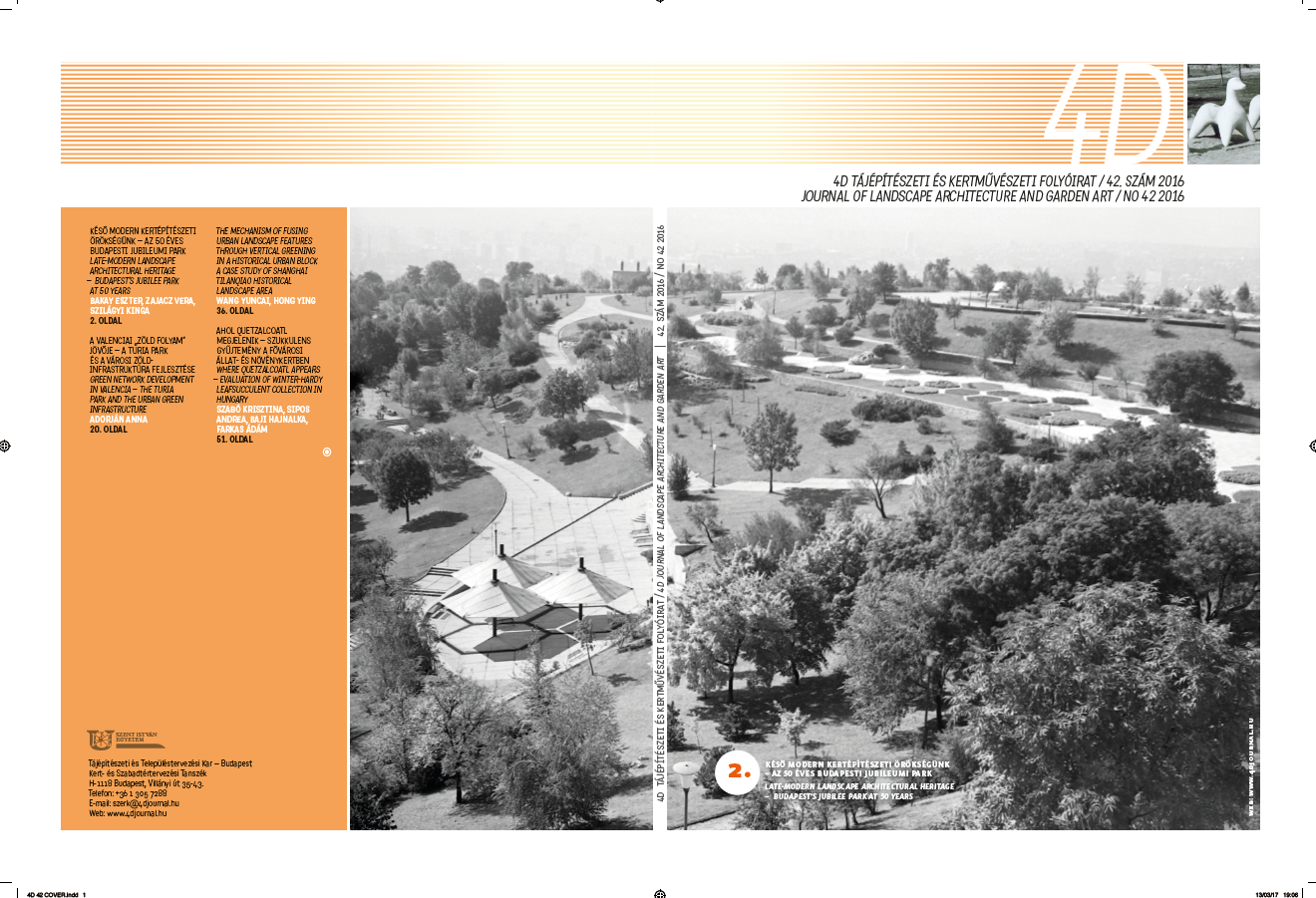Late-modern Landscape Architectural Heritage – Budapest’s Jubilee Park at 50 Years
DOI:
https://doi.org/10.36249/4d.42.6043Keywords:
Budapest, Jubilee park, modern LandscapeAbstract
The urban development of Budapest between 1950 and 1980 resulted in a capital region with a population of two million, partially because of the Great Budapest concept of the previous decade, in which first just small housing units and from the seventies intensive housing estates led by industrial technology were developed to ease a tremendous housing shortage. During the housing estate developments, a new urban design notion and regulation tool, the so-called ‘normative green surface supply’, was introduced which produced large, connected green surfaces within the housing estate developments. These often took the form of local parks and public gardens. But on the other hand, the city accomplished very little in building new city parks. According to landscape architects who practiced during this time, 75-80% of the projects were related to housing estate green spaces. Besides the existing historical parks of Budapest (Margaret Island, City Park, People's Park), only two new parks were built in those decades, both on the Buda side of the Danube; in the 1960s Jubileum (Jubilee) Park and Taban at the Gellért Hill, and in the 70s the Shipyard Island Park on a Danube island. In spite of the large green surfaces created during the second half of the 20th century, Budapest is still considered as lacking in adequate amounts of green space for a European capital.
References
Bakay, Eszter (2013): Retroterek, retroparkok, (Retro squares, retro parks) TERC Kiadó, Bp., ISBN: 9789639968943
Bakay, E., Hutter, D., Szilágyi, K. The Evolution of Open Spaces and Green Surfaces on High-Density Developments Since 1950. Acta Universitas Sapientiae, Agriculture and Environment 2011.
Csorna Antal: Mikrobusz járatok a Gellérthegyre, (Van service to Gellért Hill) Budapest (the periodical of the capitol), IX. évf. 6.szám
Csepeli-Knorr Luca (2011) : Korai modern szabadtérépítészet (A közparktervezés-elmélet fejlődése az 1930-as évek végéig),(Early modern openpace design – The development of public openspace design tilt he end of 1930s) BCE Tájépítészeti kar doktori disszertáció, 2011
Grün modern - Gärten und Parks der 1950er bis 1970er Jahre (Green modern – Gardens and Parks between 1950s and 1970s) (Dokumentation der Tagung am 15. und 16. Oktober 2013, Hamburg), BHU (Bund Heimat und Umwelt in Deutschland, Bonn 2013. ISBN: 978 3092537403507
Hlatky K: Zöldkalauz, (Green guide) 2001, Magyar Almanach Kiadó
Hutter D.: Budapest zöldfelületi rendszerének fejlesztése vasúti rozsdaterületek felhasználásával (Improving the green system of Budapest by transforming railway rust areas) BCE Tájéptészeti Kar doktori disszertáció, 2015
Internationale Kongress: Grünräume der 1950er- und 1960er-Jahre zwischen Verlust, Schutz und neuer Wertschätzung (International Congress: Green areas of the 1950s and 1960s between loss protection and appreciation) (Szimpózium az 1950-es és 1960-as évek zöldfelületeiről) Bécs, 2014. 09. 26-28.
Hauxner, Malene (2003): Open to sky, Arkitektens Forlag/The Danish Architectural Press, ISBN:87-7407-257-9
Jankovich Oszkár: A Jubileumi Park, (The jubileum park) Budapest (a főváros folyóirata), IX. évf. 6.szám
Radó Dezső: Budapesti parkok és terek, (Parks and squares of Budapest) ,Magyar Nemzeti Galéria, 1985
https://de.wikipedia.org/wiki/G59_1._Schweizerische_Gartenbau-Ausstellung- 2016.02. 20-án
https://en.wikipedia.org/wiki/G59_%E2%80%93_1st_Swiss_Horticulture_Exhibition
http://fovarosi.blog.hu/2014/05/05/otven_eve_irtak_1964_majus
www.domomoco 2016.com
www.openbuildings.com
www.budapest-foto.hu
Downloads
Published
Issue
Section
License
Copyright (c) 2024 Karlócainé Bakay Eszter, Szilágyi Kinga, Zajacz Vera

This work is licensed under a Creative Commons Attribution-NonCommercial-NoDerivatives 4.0 International License.
A folyóirat Open Access (Gold). Cikkeire a Creative Commons 4.0 standard licenc alábbi típusa vonatkozik: CC-BY-NC-ND-4.0. Ennek értelmében a mű szabadon másolható, terjeszthető, bemutatható és előadható, azonban nem használható fel kereskedelmi célokra (NC), továbbá nem módosítható és nem készíthető belőle átdolgozás, származékos mű (ND). A licenc alapján a szerző vagy a jogosult által meghatározott módon fel kell tüntetni a szerző nevét és a szerzői mű címét (BY).



